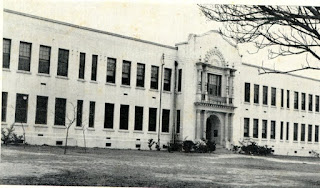EXTRACTS OF 1920 (Part 1)
In the jubilation following the end of World War I, the public-spirited citizens of Dublin began to push to build a “Community Building.” The old Hightower home place at the corner of Academy Avenue and South Monroe Street (just east of the future Fred Roberts Hotel) was selected to erect a suitable structure in line with the city’s growing business and cultural status in the state.
As the enthusiasm behind project began to wane, J.M. Finn, Dublin’s most influential citizen, called for the completion of building as a memorial to America’s victory during the war. With the boll weevil wreaking havoc across the county, a perennial state leader in cotton production, excess funds for investments were drying up. By April, the promoters resigned themselves to the fact that their dream was fruitless.
An ad for the sale of the Community Building Corporation Property was published and within two weeks, J.M. Page, H.C. Thompkins, T.A. Curry, Sr., Frank Donaldson, and I.L. Duggan bought the property for $30, 000.00, returning a $15,000.00 profit to the initial investors.
As Dublin’s schools were becoming overcrowded, the school board voted to build a new grammar school on North Calhoun Street. Within a decade and a half, the high school was moved to the spot until it was burned by a student in the early 1950s and then replaced with a new complex in the 1950s, which included a high school, junior high school, and elementary school.
E.G. Simmons built a two-story lavish brick home on Bellevue just beyond Mimosa Street, near the home of A.B. Embanks on Bellevue Avenue. The residence, constructed with hardwood floors, and cost about $15,000.00. Today, in 2020, the house is the second oldest brick home in the city and is the home of the Will and Natalie Curry family.
The Corker Building, built in 1899, was sold to Dr. W.R. Brigham for $20,000.00. The building cost about $8,000.00 and was one of the first office buildings in the city. Today, the recently renovated building is worth several million dollars. (Curry Insurance Agency, 2020)
The Crystal Theater added a photoplayer to add music to its silent movies. (Deano’s 2020)
The first Department of Retail Trade was organized by L.M. Maddox, Chairman; F.J. Schiff, W.R. Smith, J.C. Mathis, J.E. Burch, Eldridge Smith, Dr. T.J. Blackshear, W.H. Blinn, U.T. Joiner, and J.E. Jones.
The city of Dublin and Laurens County began to negotiate the construction of a county hospital, thirty plus years before it became a reality.
For the first time ever, welcome signs were placed at highway entrances to Dublin.
The influenza pandemic, which began mostly in Europe in 1917 during World War I, continued into 1920. The ban on school classes and public gatherings was finally lifted in the third week of March, despite the fact that 65 new cases were just reported throughout the county. The average attendance in the city schools was down to 825 out of 1200 enrolled students in the white schools and was down from 784 students enrolled to an average daily attendance of 525 in the colored schools.
Dublin school children raised $171.00, 1/40 of Georgia's quota, toward a memorial marker given to France and to be placed on the Marne battlefield.
Policeman Charlie Mead discovered what he thought were white bear tracks along the sidewalks of Jackson Street. He cautiously followed the tracks to where they ran into the Crystal Theater. There he found an amused Bob Hightower, who had painted the tracks to promote the movie, "Back to God's Country", at the Crystal. The policeman was not amused and ticketed Hightower for defacing the sidewalks, a minor violation of the city code. The stunt may cost the affable Hightower the sum of $25.00.
Since 1920 was a major national, state, and local campaign year, politicians descended on Dublin like summer bugs on a bright porch light. Clifford Walker, a future governor, spoke to 800 people at the courthouse. Thomas E. Watson, a popular, perennial, populist presidential candidate for three decades, spoke before a throng of his steadfast supporters at Stubbs Park on July 31 during his successful Senate campaign. Upon his election, Senator Watson hired Sara Orr as one of the youngest and few female secretaries on Capitol Hill. United States Senator Hoke Smith spoke to his supporters in front of the courthouse on April 10, 1920.
Dublin attorney George B. Davis announced his campaign for Attorney General of Georgia, while rumors were emanating out of Florida that Dublin native Brixton Beecham, then a resident of Orlando, Florida, might become Florida's next governor.
The annual Chautauqua opened on April 29. The educational, religious, scientific, and sometimes political event, the most costly in 7 years, featured Olcott Light Opera Singers, Dr. Wm. A. Colledge, Great Lakes String Quartette, Bohumir Kryl's marching band, Chaster M. Sanford, local children in "The Good Fairy's Thrift, Woodland Male Quartette, and magician, Edward Reno.
J.W. Geeslin, manager of the Coca Cola Bottling Company, announced a modern ice cream plant in the old Coca Cola Bottling Company on Harrison Street between Washington and Franklin Streets. (Part of Dublin Construction complex)
A peanut shelling plant was built by the Dublin Peanut Company, composed of Izzie Bashinski, J.M. Finn, and J.R. Powel, the new plant, with a daily capacity of 20 tons per day, was a part of the county farmers and business men to diversify agricultural production in the county, which was still reeling from the invasion of the boll weevil.






Comments